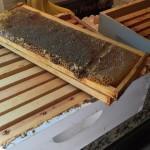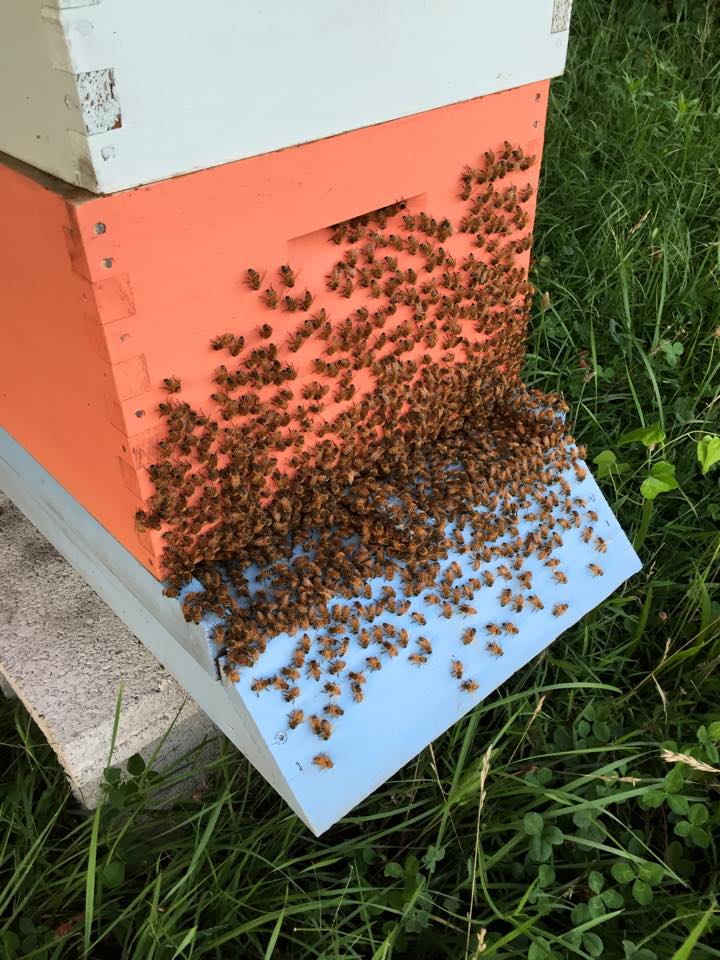There is a sound a hive makes. It is a kind of music with a pitch all its own, about an octave below middle C on the piano. Hum lightly in that key, just an easy exhale, with your teeth barely grazing each other so that they vibrate with the tone, and you almost have it: the sound of thousands of tiny wings beating at once.
Different from a cicada’s siren call, the deep Doppler effect zip of a hummingbird, and even the lazy drone of its cousin the bumblebee, the honey bee’s sound is distinct. We have a flowering cherry tree that blooms ballerina pink with flowers each spring right outside the garage. Stand still a minute beneath that tree, and a symphony unfurls. It’s easily drowned out by the lawn mowers, bird songs, and neighborhood dogs calling to each other, but if you pay attention and look up, the tree comes alive with activity, and the sound of the bees working the flowers is like a lullaby.
Approach the hives on a sunny, windless day, and from about six feet away you can start to hear the hum. If you are alert, you will see the bees at the hive entrance, like the world’s busiest airport sans air traffic controllers. They have a flight path, un-logged on any official register, but it’s always the same direction of takeoff, out and to the right, avoiding the hedgerow. Their landing strip is short, roughly 14-16 inches wide depending on the size of the hive, and the incoming bees navigate carefully, their legs yellow or orange with their pollen cargo.
In winter, the hive makes a different, softer sound. Then, the colony is clustered deep inside, forming a ball around the queen, the hive’s jewel. I trek out back to the tree line to check on them in the cold, the frosty pasture grass crunching underfoot. No flying in winter. The bees stay inside, furiously fanning their wings to keep the hive temperature around 94 degrees. I place my ear against the side of the hive and give the wood a sharp rap. Inside, the bees respond with a loud buzz: “Nobody’s home!” they grouse, “Go away!”
As Winnie the Pooh quips, “You can never tell with bees.” Beehives have moods. If a storm front is near, if there’s trouble with the queen, or if you’re out to rob their hard-won honey, tempers flare. I’ve only been at this a few years and am still a novice beekeeper, but several well-placed stings have taught me to respect these moods. This past week, we harvested the summer’s honey from our few hives. It must be some sort of penance that the honey harvest occurs when outside it feels roughly like the surface temperature of the sun. So you work quickly, both to disturb the bees as little as possible and to survive impending heatstroke.
Once I opened the cover and took apart a few boxes from the hive, they knew something was up. Smoke from the pine-filled smoker masked their pheromones and sent them downwards into the deepest part of the hive. Still, that familiar pitch changed from the nonchalant hum to a higher pitched clarion call. The bees lined up with just their heads peeking out along the top of one of the wooden frames, figuring out my intentions. They looked like little children from an illustrated nursery rhyme, all tucked under the covers up to their noses. Except they were wide awake, on alert.
As I removed the frames, heavy with comb and honey, I had to give each one a hard shake to remove the bees that clung to it and used a soft long-bristled bee brush to scoot the persistent ones away. Each hard shake sent hundreds of bees flying, the buzz one of unmistakable annoyance. Only one kamikaze bee  was particularly foul-tempered, and her stinger pegged me in the thigh like an assassin’s dagger, twisting at its mark. I could do nothing but let the stinger pulse while I held the frame full of bees. I would have to wait to remove it once I peeled off my sweaty clothes in the safety of the house. Fair enough. It takes 12 bees their entire lives to make a single teaspoon of honey, and we took over four gallons of their labor. I conceded the sting.
was particularly foul-tempered, and her stinger pegged me in the thigh like an assassin’s dagger, twisting at its mark. I could do nothing but let the stinger pulse while I held the frame full of bees. I would have to wait to remove it once I peeled off my sweaty clothes in the safety of the house. Fair enough. It takes 12 bees their entire lives to make a single teaspoon of honey, and we took over four gallons of their labor. I conceded the sting.
Beekeeping is a funny term. Can you really “keep” tens of thousands of free-flying insects? I think of it more like bee tending, which sounds a lot like “pretending” if you say it out loud. I give them a home (which they’re free to leave) and occasional food and parasite control, but they do all the rest. Tending bees has a domino effect. All of a sudden, you become more attuned to the weather and insecticide applications on nearby yards and farms. A whole world of botany opens up as you track what plants flower during which times of the year. You can barely mow the lawn anymore because you regret haplessly bowling over a patch of clover where bees flit back and forth.
These are insects, and they have the six legs to prove it. I feel no affinity for the ants, beetles, or garden pests I see every day. But the bees are “my girls.” All but a few hundred are female, rearing the young, feeding the colony, building wax comb, and crafting golden honey with creativity and beauty. They care for the queen, keep the hive clean, and occasionally give their lives in defense of their home. And, they appreciate a pretty bouquet of flowers. Not so different from my own life, and most women I know, come to think of it.
The more time I spend in the hives, the more I see the parallels. My home, my work, everyone’s singular, individual gifts and missions. Lots of days can seem like drudgery and hassle. Occasionally, one of us gets run over by a passing lawn mower. Rather than a Keeper, we have one who gently tends. We are free to fly away if we wish, but what a delight to the Tender when we stay. I am surrounded by friends and family who don’t hesitate to rush in with a cooperative instinct to help and love. We’re in this together. And the rewards. The rewards are so, so sweet.









I see you also tend to the sounds of life. Your writing is a lively pleasant sound, too.
Loved it! Having never kept bees myself, there is a lot of good info. in that article!